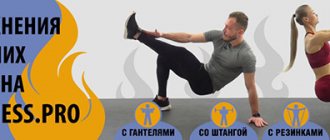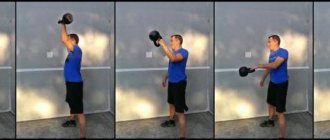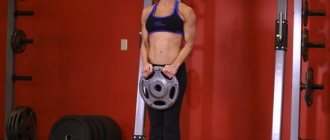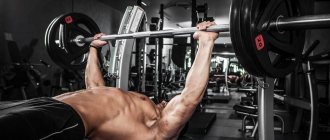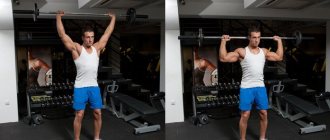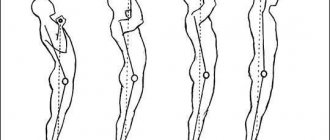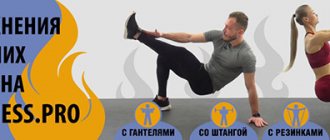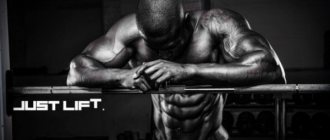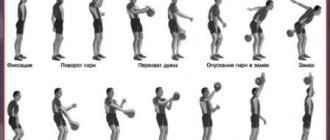The barbell jerk is a competitive movement in weightlifting that involves almost all muscle groups and consists of several phases. In general, all exercises in weightlifting consist of several phases, which facilitates the process of learning the technique. The barbell push consists of lifting the barbell from the floor, pulling, cleansing the barbell, and a scissors push or push. Beginners are advised to first learn the technique of performing barbell squats and military presses, then deadlifts, and then include barbell cleans in the program, while simultaneously practicing the entire movement with a stick. All this is necessary in order to develop technical skill, without which there is nothing to look for in weightlifting.
The barbell push is not as complex an exercise as the snatch, but even in it, strength indicators are determined, first of all, not by muscle strength, but by the athlete’s ability to coordinate their work, which is why it is so important to permanently improve one’s technical skills. The strength characteristics of the muscles are, of course, just as important, but for the most part they should be trained in exercises that are, as it were, intermediate stages of competitive movement, or in special general developmental strength exercises. This does not mean that there is no place
Why is this exercise needed?
As a child, even before I became seriously interested in sports, I loved watching weightlifting competitions. This is truly a great sport, and many athletes, such as Yuri Petrovich Vlasov, Leonid Ivanovich Zhabotinsky, Vasily Ivanovich Alekseev and others, have left a truly enormous sports legacy, and their phenomenal results continue to motivate athletes from all over the world even after decades.
Weightlifters perform the clean and jerk as part of a competition, and their main goal is to lift the heaviest weight. In CrossFit, we have slightly different goals, performing the clean and jerk primarily to increase tonnage and overall intensity of the workout.
I don’t know about you, but for me, complexes that contain a barbell push are the most difficult due to the decent working weights and the need to strictly follow the correct technique. If you look at the total tonnage per workout, it's a huge number. But after completing all the complexes, no matter how difficult they may be, a feeling of satisfaction comes, because I realize that I worked 100%.
During the barbell push, the following muscles work: quadriceps, glutes, spinal extensors and deltoids. Therefore, I recommend wisely distributing the load throughout the week, for example, not performing heavy weightlifting exercises in one workout and heavy deadlifts and front squats in another. Thus, your muscles simply will not have time to recover, overtraining will occur, which will lead to a complete lack of progress in training, constant muscle pain, chronic fatigue, sleep disturbances and exhaustion of the central nervous system.
Work of muscles and joints
Weightlifting is distinguished from other strength sports, for example, powerlifting, by the extreme dynamism of all competitive movements, therefore, during their execution, not only the fast muscle system, but also the slow muscle fibers take on the load. Slow fibers are mainly concentrated in the postural muscle layers, which are innervated entirely, so the push involves them all. Fast muscle fibers are located in the superficial muscles, whose work is more individualized. But in this case, the athlete loads all the muscles, it’s just that the degree of their innervation varies depending on the phase of the exercise.
During the barbell push, almost all muscle groups receive a load, which, accordingly, loads almost all joints, but in the first phase the knees and hip joint work more, and in the final phase – the shoulder and knee joints. This is precisely the reason for the difficulty of coordinating movements, but at the same time it is precisely due to the fact that the load is distributed among a large number of muscle groups that it is possible to lift such impressive weights. True, you can’t do without stretching, so anyone who wants to do weightlifting, or wants to include weightlifting exercises in their training program, needs to devote time to stretching .
Technique for performing the barbell push
Due to the technical complexity of the exercise, I recommend seeking help from a competent specialist. Below I will try to describe in as much detail as possible the correct technique for performing a push, but only with an outside glance can you soberly evaluate the technique, point out mistakes and help the student achieve the desired result.
The standing barbell jerk is a technically difficult exercise, and professional weightlifters spend years honing the technique. The barbell push involves a huge range of motion, and the movement itself consists of several stages: lifting the barbell off the floor, lifting, squatting, pushing out and scissoring squat. Each stage should be worked out separately in order to fully understand the biomechanics of movement. Under no circumstances should you rush if you are not given a particular stage. Start practicing them with minimal weights until the trainer is happy with your technique. After this, you can begin to perform the clean and jerk, again, starting with light weights.
The barbell comes off the floor
Starting position:
- Feet shoulder width apart;
- Hands hold the bar slightly wider than shoulder-width apart with a lock grip;
- The toes are spread slightly to the sides, the center of gravity lies on the heels;
- We keep our back perfectly straight, while maintaining natural lordosis in the lower back;
- We move our shoulders slightly back, looking forward.
Our task is to use the powerful force of the legs and back to lift the barbell from the floor and give it the necessary acceleration in order to throw it onto the chest. Raise the barbell just above the knee, while the bar should be as close to the shin as possible.
Detonation
In order to accelerate the barbell and throw it onto your chest, you need to straighten your legs and body, stand on your toes (a small jump is allowed), bend your arms and “accept” it with your chest, while at the same time starting to lower yourself into a squat. In this case, your elbows should be brought out in front of you.
Podsed
When the barbell is at the level of the solar plexus, we begin to squat under it, while moving it with the movement of our shoulders towards our chest. If everything is done correctly, approximately halfway through the squat, the bar should “fall” onto your chest. We sit with her on our chest in full amplitude, stand up and fixate ourselves. We have a couple of seconds to gather our strength and prepare to push out. During the push of the barbell, keep your elbows turned away from each other so that the barbell lies not on your chest, but on your shoulders.
Pushing + scissor squat
With an explosive movement of the legs and buttocks, we begin to push the barbell up, while performing a scissor squat. Some weightlifters perform a split squat, but due to the anatomical characteristics of most people, the scissor squat is easier for them and allows them to lift more weight. We make a small jump, bringing one leg forward and the other back. The movement is reminiscent of lunges with a barbell. As soon as we have caught the balance point, we put the back foot to the front and fixate in this position. Now you can throw the barbell on the floor.
Detailed training on the barbell push technique in the video:
Another useful video:
https://youtu.be/o8fAxrae8XM
Snatch and Jerk Phases
The snatch and clean for the subsequent push (not the push itself) have a similar execution technique. Therefore, they can be considered together. These two elements include the following phases:
- Start is the starting position of the athlete from which he begins the movement.
- Traction - lifting the projectile off the floor and raising it to above the knees.
- Detonation - giving a projectile a sharp upward acceleration.
- Squatting (walking away) - “diving” under the barbell and fixing it on outstretched arms (or on the chest for a push).
- Squat raise - the athlete rises with a barbell.
- Fixation is the end of the movement.
If the barbell is taken to the chest and then it is necessary to perform a push, then the movement continues in the following phases:
- Half squat is a small squat.
- Ejection is a sharp upward push of the projectile.
- Squatting - going under the barbell.
- The squat raise is the final lift with the barbell at outstretched arms.
- Fixation is the end of the movement.
Typical beginner mistakes
- Pushing the barbell is carried out primarily due to the force of the quadriceps and buttocks, while the deltoids and triceps are responsible for stabilizing the projectile. Do not confuse the clean and jerk with a push press or a military press, here we are not pumping our shoulders, we are breaking the laws of physics.
- You should not perform snatches and jerks in regular sneakers or sneakers. Spend a few thousand rubles and buy specialized high-quality weight bars; they will help keep your body in the correct position during squats. At one time, I added 40 kg to my squats with a barbell in two workouts, simply by switching from sneakers to barbells. Progress in the clean and jerk was also not long in coming.
- Contact a smart trainer. On your own, you are unlikely to be able to establish the correct push technique; only with an outside glance can you make adjustments to the technique, based on the individual anatomical characteristics of the body.
- Pay special attention to warming up your hands and elbows. When the barbell is placed on the chest and the elbows are brought forward, the joints and ligaments experience enormous stress. Use statodynamic exercises to further strengthen your ligaments and tendons.
Podsed (care)
Thanks to the acceleration applied at the detonation stage, the bar, as they say, flies up.
In this phase, the athlete must quickly get under it. When the bar has lost acceleration and is already moving downwards, it is much more difficult to accept it. During this phase of the movement, the back remains arched and the pelvis is laid back. Hands actively interact with the projectile. The athlete takes the barbell with outstretched arms (when performing a snatch) or on the chest (if a push is planned next).
The athlete’s legs can be in different positions:
- Low squat (legged), hips pressed to the stomach.
- Scissors, one leg in front, one leg behind, as in a deep lunge.
Correct and quick squatting creates an optimal “base” for subsequent lifting.
Standards
Next, we have prepared for you the official standards for the barbell push for the year, approved by the Russian FTA.
Table of standards for men (sum: clean and jerk + snatch, kg):
| Weight category | Combined total (kg) | ||||||||
| Adults | Boys 11-15 years old | ||||||||
| MSMK | MS | KMS | 1 | 2 | 3 | 1 yun | 2 yun | 3 yun | |
| 34 kg | – | – | 90 | 82 | 76 | 70 | 64 | 58 | 52 |
| 38 kg | – | – | 105 | 96 | 88 | 80 | 72 | 64 | 56 |
| 42 kg | – | – | 120 | 110 | 100 | 90 | 80 | 70 | 60 |
| 46 kg | – | – | 130 | 119 | 108 | 97 | 86 | 75 | 64 |
| 50 kg | – | 180 | 150 | 137 | 124 | 110 | 96 | 82 | 68 |
| 56 kg | 255 | 205 | 170 | 154 | 138 | 122 | 106 | 90 | 74 |
| 62 kg | 285 | 230 | 190 | 170 | 152 | 134 | 116 | 98 | 80 |
| 69 kg | 315 | 255 | 205 | 185 | 165 | 145 | 125 | 106 | 87 |
| 77 kg | 350 | 280 | 235 | 210 | 187 | 164 | 141 | 118 | 95 |
| 85 kg | 365 | 295 | 250 | 225 | 200 | 175 | 151 | 127 | 103 |
| 94 kg | 385 | 310 | 260 | 235 | 210 | 185 | 162 | 137 | 112 |
| +94 kg | – | 315 | 265 | 240 | 215 | 190 | 167 | 142 | 117 |
| 105 kg | 400 | 320 | 270 | 245 | 220 | 195 | – | – | – |
| +105 kg | 415 | 325 | 275 | 250 | 225 | 200 | – | – | – |
Table of standards for women (sum: clean and jerk + snatch, kg):
| Weight category | Combined total (kg) | ||||||||
| Adults | Girls 11-15 years old | ||||||||
| MSMK | MS | KMS | 1 | 2 | 3 | 1 yun | 2 yun | 3 yun | |
| 34 kg | – | – | 80 | 72 | 66 | 60 | 54 | 48 | 42 |
| 36 kg | – | – | 85 | 77 | 71 | 65 | 58 | 51 | 44 |
| 40 kg | – | – | 90 | 83 | 76 | 69 | 62 | 55 | 48 |
| 44 kg | – | 120 | 100 | 92 | 84 | 76 | 68 | 60 | 52 |
| 48 kg | 165 | 130 | 105 | 96 | 88 | 80 | 72 | 64 | 56 |
| 53 kg | 180 | 140 | 115 | 106 | 97 | 88 | 79 | 70 | 61 |
| 58 kg | 190 | 150 | 125 | 115 | 105 | 96 | 86 | 76 | 66 |
| 63 kg | 205 | 160 | 135 | 125 | 115 | 104 | 93 | 82 | 71 |
| 69 kg | 215 | 170 | 145 | 135 | 125 | 113 | 101 | 89 | 77 |
| 75 kg | 225 | 180 | 150 | 138 | 127 | 116 | 105 | 94 | 83 |
| +75 kg | – | 185 | 155 | 143 | 132 | 121 | 110 | 99 | 88 |
| 90 kg | 230 | 190 | 160 | 150 | 140 | 130 | – | – | – |
| 90 kg+ | 235 | 195 | 165 | 155 | 145 | 135 | – | – | – |
Examples of training with jerks[edit | edit code]
Workout 1 – running backwards
- maximum number of approaches in 12 minutes 15 box jumps
- 15 jerks
- 300 meters running backwards
What are the benefits of running backwards?
Of course, we run backwards slower than the other way around. But this is not a problem for TD, where we repeat the exercises, albeit with increased intensity, but below the maximum. Running backwards is effective
and an original exercise for functional and amazing results in the development of the muscles of the posterior region. In addition, this exercise allows you to systematically start the movement from the forefoot, thus reducing the impact on the ground and developing the sensitivity of the muscle receptors of the foot
Workout 2 – “explosive”, but not painful
- minute start for 20 minutes 50m sprint
- 4 jerks
- 6 burpees
Training 3 – “reveals the truth”
17 minutes to find your maximum in the deadlift, squat and snatch. Time and exercise management is completely at your discretion
Of course, you should strive for the highest results
How to progress on the clean and jerk?
The secret to a powerful push is practicing individual phases of the movement and performing auxiliary exercises.
Do the following exercises:
- push push of the barbell to separately practice pushing the barbell above you;
- overhead squats and front squats to strengthen the squat;
- heavy lunges with a barbell on your shoulders to make it easier to get up from scissors;
- push with pause - this exercise involves holding a 1-3 second half squat or full squat before completing the exercise;
- deadlifts from plates, hyperextensions with additional weights and your favorite exercises for the abs and oblique muscles of the abdomen to more clearly hold the body while rising from a squat and not get injured in the lumbar spine.
Crossfit complexes with barbell snatch
Weightlifting exercises formed the basis of more than a dozen functional complexes. We will look at the most interesting of them in the table below.
| Dinner of a mammoth | Perform 15 barbell push-ups, 30 double jump ropes, 15 barbell push-ups, 20 burpees, 20 front squats, 30 double jump ropes, and 25 barbell snatches. The goal is to complete everything in the minimum amount of time. |
| The Big Dirty | Complete a 400-meter sprint, followed by 40 each of back squats, front squats, and overhead squats. Then again a 400-meter race and 40 bench presses and jerks. Then a 400-meter race, 40 power cleans and snatches. At the end there is another 400 meter race. |
| Crossfit Games Open 15.1 | Perform 15 calf raises, 10 deadlifts, and 5 barbell snatches. The goal is to complete the maximum number of rounds in 9 minutes. |
Detonation
The third period consists of a phase of bringing the knees (the task is to prevent a significant decrease in the speed of movement of the barbell (M.P. Mikhailyuk), change the direction of the trajectory of its movement and take a rational pose to ensure the effectiveness of the actions of the body parts in the next phase - the final acceleration, the task of which is achieve optimal boom speed at higher altitudes). Deliberately teaching practitioners to “bring their knees” leads to major flaws in the exercise technique. This phase lasts 0.14-0.16 s in junior weightlifters; for masters of sports - 0.1 1-0.13 s. When the knees are brought in, the pressure on the support decreases noticeably and amounts to 65-75 percent of the weight of the barbell. Bringing the knees in faster helps combat a significant decrease in the lifting speed of the projectile. Here the shoulders and head begin to move in an upward-backward arc, and the barbell moves up and slightly forward.
The OCM still passes through the middle of the support area. The athlete takes a comfortable position before the final acceleration phase: he feels an even distribution of the weight of the body and the barbell on both feet, with support along the entire plantar part from the toes to the heels; the arm muscles are tense, the back is slightly bent or straight, the head is slightly laid back, the centers of the shoulder joints are projected above the bar; The bar is located above the knee joints at the level of the lower third of the thighs.
At the beginning of the final acceleration phase, the angles in the hip and knee joints are unequal, limited by the back of the thighs and the plane of the shins - more obtuse. The position at the end of bringing the knees depends on the athlete’s body type (A.I. Mulchin): the greatest angles in the knee joints are for dolichomorphs and the smallest for brachymorphs (according to the body type: 133.3, 126.6 and 122.6 degrees). In the hip joints, there is only a tendency for them to increase in brachymorphs (102.0, 103.6 and 104.3 degrees).
In the final acceleration phase, the legs and torso straighten almost completely; at the end, the athlete momentarily raises his heels, resting his feet on the platform with a place in the area of the metatarsal bones. The ability to straighten the legs more in the final acceleration phase is acquired in the process of sports improvement: for beginners, depending on the weight of the barbell at the end of this phase, the angles in the knee joints are 164-155 degrees, for masters of sports - 168-163 degrees, for highly qualified weightlifters they are greater. All weightlifters with increasing weight of the barbell more noticeably under-straighten their legs at the knee joints (O. I. Livanov, A. I. Falameev),
The projectile exit speed in the final acceleration phase is 1.6-2.1 m/s. Let us remind you that tall weightlifters lift the barbell faster, short weightlifters lift the barbell more slowly; As its weight increases, the maximum departure speed decreases. At the end of the lift, highly qualified athletes give the barbell a higher speed than untrained athletes (when performing an exercise with the same weight in percentages of the best result).
Before going under the bar, the legs and torso are straightened and slightly tilted back from the vertical. The gravity forces of the barbell and the athlete in this position balance each other. The OCMs projection is located within the reference area. For the same weightlifter, at the end of the final acceleration phase (before leaving), the position of the body in relation to the vertical is not constant. Athletes lean back significantly as the weight of the apparatus increases; This is especially noticeable among athletes in light weight categories.
The duration of the 2nd and 3rd periods depends on the qualifications of the performer and the weight of the apparatus: for junior weightlifters with a barbell weight of 60 to 100 percent, it is 0.71-0.93 seconds; for qualified athletes - 0.70-0.88 seconds. The time for applying “explosive” muscle force to the barbell in the final acceleration phase increases, this is especially noticeable among masters of sports. This phase with different weights of the bar lasts 0.12-0.16 seconds for them, and for junior athletes it lasts 0.12-0.13 seconds (V. A. Salnikov, A. I. Falameev, B. V. Kimeisha ). A longer impact on the bar with a rigid support makes it possible to give it significant speed (according to V.I. Frolov - 1.85-2.15 m/s) and ensure its movement by inertia to a significant height - up to 17-23 cm (IAbadzhiev , V. Furnadzhiev).
Traction
The second period includes the phase of interaction of the athlete with the barbell (the task is to create a rigid system of transferring forces from the legs and torso to the barbell) and the phase of preliminary acceleration of the barbell (including the task of directing the barbell along the optimal trajectory, giving it the required speed of movement).
With variations of the start, the forces applied to the barbell gradually increase and, when the shoulder joints move to a position above the bar, the legs begin to actively extend, the pelvis rises up and somewhat back. At the moment of separation of the discs from the platform, the anterior part of the left and right deltoid muscles is projected in front of the bar; however, the centers of the shoulder joints should be located exactly above it. The legs rest on the platform with the entire foot.
The general (GCMs) is projected into the middle of the support area: the weightlifter feels an even distribution of the weight of the body and the barbell on both feet with support along the entire plantar part from the toes to the heels.
When lifting the barbell from 60 to 100%, among masters of sports and candidates for master of sports, the indicator of vertical support reaction in this phase (expressed as a percentage of the weight of the barbell being lifted) decreases from 240 to 153, among weightlifters of junior sports categories - from 225 to 164% (V. A. Salnikov, A. I. Falameev, B. V. Kimeisha).
So, first the bar moves upward due to the efforts of the muscles that extend the ankle and knee joints. The head in relation to the body does not change its original position. During the traction process, the arm muscles are in a highly stretched, but not tense, state. The forces from the leg muscles to the bar reach with less loss if the feet are fixed in relation to the platform, the support is rigid, the weight of the body and the barbell is distributed evenly on both legs until the end of the lift, the line of gravity passes through the middle of the support area, the pressure of the load is felt on the plantar surface feet from toes to heels, arms straight, their muscles and the muscles of the shoulder girdle stretched by the weight of the barbell. Throughout the entire process of lifting the barbell upward, the weightlifter actively interacts with the platform with his feet and pushes off from it. The relative value of the ground reaction force (as a percentage of the lifting weight of the barbell) decreases with the weight of the projectile (from 60 to 100 percent) for candidates for master of sports from 187 to 147 percent and for junior athletes - from 215 to 166 percent (V. A. Salnikov , A. I. Falameev, B. V. Kimeisha).
The speed of lifting the barbell also depends on its weight and the qualifications of the athlete: with heavier weights it decreases, the duration of the preliminary acceleration phase gradually decreases with the acquisition of sportsmanship. Thus, this indicator with a weight of 60 to 100 percent for candidates for master of sports and masters of sports is 0.17-0.25 seconds; among junior athletes -0.18-0.32 seconds.
In the preliminary acceleration phase, the bar moves not only upward, but also slightly backward (from 3 to 10 cm) towards the athlete with an average speed of 1.0-1.6 m/sec. Tall weightlifters lift the barbell faster. The distance by which the barbell moves towards the athlete increases with its weight and depends on the length of the body (A.I. Mulchin) and the angle of its inclination to the platform. In athletes of heavy weight categories, this movement is more significant (according to R. A. Roman and M. S. Shakirzyanov - up to 12 cm or more).
The bar is pulled towards the body with straight arms involuntarily due to the tension of the left and right latissimus dorsi muscles; this muscle is known to attach to the crest of the lesser tubercle of the humerus.
The movement of the barbell towards the knee joints moving backward ensures the convergence of the projections of the weightlifter’s center of mass (Cmt) and the center of gravity of the barbell (Cgg). This reduces the overturning moment of gravity of the barbell and reduces the moment resistance arm in relation to the working joints. The OCMs moves slightly backward.
The deadlift technique depends on the individual typological features of the athlete’s body structure. So, on average, when separating the bar from the platform, the angles in the knee joints reach 80-110 degrees; in weightlifters of the dolichomorphic type of body structure they are smaller than in representatives of the mesomorphic type, and in the latter they are smaller than in brachymorphic ones. The angles in the hip joints at this moment, on the contrary, are greater in dolichomorphs than in mesomorphs, and smaller in brachymorphs (A.I. Mulchin).
By the end of the pull, the angles in the knee joints reach 145-155, in the hip joints - 95-105 degrees. There is also other data on the angles in these joints at the end of the preliminary acceleration phase - 135-150 and 90-100 degrees, respectively (V.I. Frolov).
Kettlebell push and lunge: video
This exercise is aimed at developing the muscles of the shoulder body, as well as the muscles of the legs (quadriceps and gluteal muscles).
The following are exercises that you can perform as a replacement for or in addition to the double kettlebell lunge jerk. Push weights with both hands. This exercise is perfect for beginners because it has the simplest technique, but also uses the deltoids and trapezius muscles.
https://youtu.be/U6BNJoWrId8
A variation of the exercise can also be pushing the kettlebell in a long cycle. Involves raising and lowering the kettlebell to the floor on each rep. In this case, the load on the leg muscles is minimized; the main load falls on the deltoid and trapezius muscles.
The military bench press is one of the best exercises for developing the muscles of the shoulder girdle: deltoids, upper chest, and triceps. Very great importance is attached to the correct technique of the military press, otherwise the effectiveness is sharply reduced. The military press is ideal for building powerful shoulders.
Military two-handed kettlebell press. It is more difficult compared to the military barbell press, since the kettlebell is a non-standard apparatus that is more difficult to train with, especially for beginners. We recommend starting with light weights to get used to the apparatus first.
Swing the kettlebell with both hands. The exercise will help you get used to the projectile and feel it. It will work out your shoulders and back well, so it will be easier for you to start the push.
Kettlebell push with one hand. If you're just starting out, you should start by pushing the kettlebell with one hand. You need to master the correct technique and increase the number of repetitions in order to proceed to the next stage.
Push weights with both hands. If you can perform this exercise at least 10 times, then this indicates that your muscles and joints are sufficiently developed to begin learning the kettlebell push with a lunge. All you have to do is add a lunge to this exercise.
